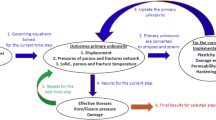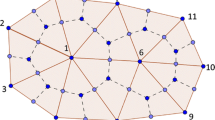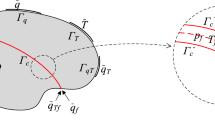Abstract
Thermal-hydro-mechanical (THM) coupled fracture propagation is common in underground engineering. Rock damage, as an inherent property of rock, significantly affects fracture propagation, but how it influences the THM coupled fracturing remains stubbornly unclear. A pore-scale THM coupling model is developed to study this problem, which combines the lattice Boltzmann method (LBM), the discrete element method (DEM), and rock damage development theory together for the first time. This model can more accurately calculate the exchanged THM information at the fluid-solid boundary and fluid conductivity dependent on fracture and rock damage. Based on the developed model, the synergistic effect of injected temperature difference (fluid temperature below rock temperature) and rock damage (characterized by the parameter “critical fracture energy”, abbreviated as “CFE”) on fracture propagation of shale are investigated particularly. It is found that: (1) the generation of branched cracks is closely related to the temperature response frontier, and the fracture process zone of single bond failure increases in higher CFE. (2) through the analysis of micro failure events, hydraulic fracturing is more pronounced in the low CFE, while thermal fracturing displays the opposite trend. The fluid conductivity of fractured rock increases with a higher injected temperature difference due to the more penetrated cracks and wider fracture aperture. However, this enhancement weakens when rock damage is significant. (3) in the multiple-layered rock with various CFEs, branched cracks propagating to adjacent layers are more difficult to form when the injection hole stays in the layer with significant rock damage than without rock damage.
Similar content being viewed by others
Data availability
The datasets generated during and/or analyzed during the current study are available from the corresponding author on reasonable request.
References
Li, T., Tang, C., Rutqvist, J., Hu, M.: TOUGH-RFPA: coupled thermal-hydraulic-mechanical rock failure process analysis with application to deep geothermal wells. Int. J. Rock Mech. Min. Sci. 142, 104726 (2021). https://doi.org/10.1016/j.ijrmms.2021.104726
Zhao, Y., Feng, Z., Feng, Z., Yang, D., Liang, W.: THM (Thermo-hydro-mechanical) coupled mathematical model of fractured media and numerical simulation of a 3D enhanced geothermal system at 573K and buried depth 6000-7000M. Energy. 82, 193–205 (2015). https://doi.org/10.1016/j.energy.2015.01.030
Yan, C., Xie, X., Ren, Y., Ke, W., Wang, G.: A FDEM-based 2D coupled thermal-hydro-mechanical model for multiphysical simulation of rock fracturing. Int. J. Rock Mech. Min. Sci. 149, 104964 (2022). https://doi.org/10.1016/j.ijrmms.2021.104964
Tomac, I., Gutierrez, M.: Coupled hydro-thermo-mechanical modeling of hydraulic fracturing in quasi-brittle rocks using BPM-DEM. J. Rock Mech. Geotech. Eng. 9, 92–104 (2017). https://doi.org/10.1016/j.jrmge.2016.10.001
Morrow, C.A., Moore, D.E., Lockner, D.A.: Permeability reduction in granite under hydrothermal conditions. J. Geophys. Res. Solid Earth. 106, 30551–30560 (2001). https://doi.org/10.1029/2000JB000010
Cai, C., Li, G., Huang, Z., Shen, Z., Tian, S., Wei, J.: Experimental study of the effect of liquid nitrogen cooling on rock pore structure. J. Nat. Gas Sci. Eng. 21, 507–517 (2014). https://doi.org/10.1016/j.jngse.2014.08.026
Bennour, Z., Ishida, T., Nagaya, Y., Chen, Y., Nara, Y., Chen, Q., Sekine, K., Nagano, Y.: Crack extension in hydraulic fracturing of shale cores using viscous oil, water, and liquid carbon dioxide. Rock Mech. Rock. Eng. 48, 1463–1473 (2015). https://doi.org/10.1007/s00603-015-0774-2
Garipov, T.T., Hui, M.H.: Discrete fracture modeling approach for simulating coupled thermo-hydro-mechanical effects in fractured reservoirs. Int. J. Rock Mech. Min. Sci. 122, 104075 (2019). https://doi.org/10.1016/j.ijrmms.2019.104075
Guo, T., Tang, S., Liu, S., Liu, X., Zhang, W., Qu, G.: Numerical simulation of hydraulic fracturing of hot dry rock under thermal stress. Eng. Fract. Mech. 240, 107350 (2020). https://doi.org/10.1016/j.engfracmech.2020.107350
Zeng, Q., Yao, J., Shao, J.: An extended finite element solution for hydraulic fracturing with thermo-hydro-elastic–plastic coupling. Comput. Methods Appl. Mech. Eng. 364, 112967 (2020). https://doi.org/10.1016/j.cma.2020.112967
Jiao, Y., Zhang, X., Zhang, H., Li, H., Yang, S., Li, J.: A coupled thermo-mechanical discontinuum model for simulating rock cracking induced by temperature stresses. Comput. Geotech. 67, 142–149 (2015). https://doi.org/10.1016/j.compgeo.2015.03.009
Li, W., Soliman, M., Han, Y.: Microscopic numerical modeling of Thermo-hydro-mechanical mechanisms in fluid injection process in unconsolidated formation. J. Pet. Sci. Eng. 146, 959–970 (2016). https://doi.org/10.1016/j.petrol.2016.08.010
Wang, Y., Ju, Y., Chen, J., Song, J.: Adaptive finite element–discrete element analysis for the multistage supercritical CO2 fracturing and microseismic modelling of horizontal wells in tight reservoirs considering pre-existing fractures and thermal-hydro-mechanical coupling. J. Nat. Gas Sci. Eng. 61, 251–269 (2019). https://doi.org/10.1016/j.jngse.2018.11.022
Chen, Z., Wang, M.: Pore-scale modeling of hydromechanical coupled mechanics in hydrofracturing process. J. Geophys. Res. Solid Earth. 122, 3410–3429 (2017). https://doi.org/10.1002/2017JB013989
Caulk, R., Sholtès, L., Krzaczek, M., Chareyre, B.: A pore-scale thermo–hydro-mechanical model for particulate systems. Comput. Methods Appl. Mech. Eng. 372, 113292 (2020). https://doi.org/10.1016/j.cma.2020.113292
Krüger, T., Kusumaatmaja, H., Kuzmin, A., Shardt, O., Silva, G., Viggen, E.M.: The Lattice Boltzmann Method - Principles and Practice. Springer (2016)
Wang, M., Feng, Y.T., Owen, D.R.J., Qu, T.M.: A novel algorithm of immersed moving boundary scheme for fluid–particle interactions in DEM–LBM. Comput. Methods Appl. Mech. Eng. 346, 109–125 (2019). https://doi.org/10.1016/j.cma.2018.12.001
Jiao, K., Han, D., Li, J., Bai, B., Gong, L., Yu, B.: A novel LBM-DEM based pore-scale thermal-hydro-mechanical model for the fracture propagation process. Comput. Geotech. 139, 104418 (2021). https://doi.org/10.1016/j.compgeo.2021.104418
Khalilpour, S., BaniAsad, E., Dehestani, M.: A review on concrete fracture energy and effective parameters. Cem. Concr. Res. 120, 294–321 (2019). https://doi.org/10.1016/j.cemconres.2019.03.013
Ma, G., Zhou, W., Chang, X.L.: Modeling the particle breakage of rockfill materials with the cohesive crack model. Comput. Geotech. 61, 132–143 (2014). https://doi.org/10.1016/j.compgeo.2014.05.006
Mahabadi, O.K., Lisjak, A., Munjiza, A., Grasselli, G.: Y-Geo : new combined finite-discrete element numerical code for geomechanical applications. Int J Geomech. 12, 676–688 (2012). https://doi.org/10.1061/(ASCE)GM.1943-5622.0000216
Camanho, P.P., Davila, C.G., Moura, D.: Numerical simulation of mixed-mode progressive delamination in composite materials. J. Compos. Mater. 37, 1415–1438 (2003). https://doi.org/10.1177/002199803034505
Gmati, H., Mareau, C., Ammar, A., El Arem, S.: A phase-field model for brittle fracture of anisotropic materials. Int. J. Numer. Methods Eng. 121, 3362–3381 (2020). https://doi.org/10.1002/nme.6361
Guo, J., Lu, Q., Zhu, H., Wang, Y., Ma, L.: Perforating cluster space optimization method of horizontal well multi-stage fracturing in extremely thick unconventional gas reservoir. J. Nat. Gas Sci. Eng. 26, 1648–1662 (2015). https://doi.org/10.1016/j.jngse.2015.02.014
Guo, J., Lu, Q., Chen, H., Wang, Z., Tang, X., Chen, L.: Quantitative phase field modeling of hydraulic fracture branching in heterogeneous formation under anisotropic in-situ stress. J. Nat. Gas Sci. Eng. 56, 455–471 (2018). https://doi.org/10.1016/j.jngse.2018.06.009
Liu, Z., Pan, Z., Li, S., Zhang, L., Wang, F., Han, L., Zhang, J., Ma, Y., Li, H., Li, W.: Study on the effect of cemented natural fractures on hydraulic fracture propagation in volcanic reservoirs. Energy. 241, 122845 (2022). https://doi.org/10.1016/j.energy.2021.122845
Wang, F., Liu, S., Ji, K.: Numerical study on abrasive machining of rock using FDEM method. Simul. Model. Pract. Theory. 104, 102145 (2020). https://doi.org/10.1016/j.simpat.2020.102145
Liu, L., Ji, S.: Bond and fracture model in dilated polyhedral DEM and its application to simulate breakage of brittle materials. Granul. Matter. 21, 1–16 (2019). https://doi.org/10.1007/s10035-019-0896-4
Pezeshki, M., Loehnert, S., Wriggers, P.: 3D fracture modeling by extended finite element method and gradient enhanced damage. Pamm. 17, 263–264 (2017). https://doi.org/10.1002/pamm.201710101
Wu, Z., Ma, L., Fan, L.: Investigation of the characteristics of rock fracture process zone using coupled FEM/DEM method. Eng. Fract. Mech. 200, 355–374 (2018). https://doi.org/10.1016/j.engfracmech.2018.08.015
Galindo Torres, S., Pedroso, D., Williams, D., Li, L.: Breaking processes in three-dimensional bonded granular materials with general shapes. Comput. Phys. Commun. 183, 266–277 (2012). https://doi.org/10.1016/j.cpc.2011.10.001
Behraftar, S., Galindo Torres, S., Scheuermann, A., Williams, D., Marques, E., Janjani Avarzaman, H.: A calibration methodology to obtain material parameters for the representation of fracture mechanics based on discrete element simulations. Comput. Geotech. 81, 274–283 (2017). https://doi.org/10.1016/j.compgeo.2016.08.029
Chen, Z., Jin, X., Wang, M.: A new thermo-mechanical coupled DEM model with non-spherical grains for thermally induced damage of rocks. J. Mech. Phys. Solids. 116, 54–69 (2018). https://doi.org/10.1016/j.jmps.2018.03.023
Zhang, Z.F., Eckert, J.: Unified tensile fracture criterion. Phys. Rev. Lett. 94, 1–4 (2005). https://doi.org/10.1103/PhysRevLett.94.094301
Wu, Z., Zhou, Y., Weng, L., Liu, Q., Xiao, Y.: Investigation of thermal-induced damage in fractured rock mass by coupled FEM-DEM method. Comput. Geosci. 24, 1833–1843 (2020). https://doi.org/10.1007/s10596-020-09970-5
Ju, Y., Zhang, Q., Zheng, J., Chang, C., Xie, H.: Fractal model and lattice Boltzmann method for characterization of non-Darcy flow in rough fractures. Sci. Rep. 7, 1–9 (2017). https://doi.org/10.1038/srep41380
Chen, L., Kang, Q., Viswanathan, H., Tao, W.: Pore-scale study of dissolution-induced changes in hydrologic properties of rocks with binary minerals. Water Resour. Res. 50, 9343–9365 (2014). https://doi.org/10.1002/2014WR015646
Chen, Y., Müller, C.R.: A Dirichlet boundary condition for the thermal lattice Boltzmann method. Int. J. Multiph. Flow. 123, 103184 (2020). https://doi.org/10.1016/j.ijmultiphaseflow.2019.103184
Du, R., Shi, B., Chen, X.: Multi-relaxation-time lattice Boltzmann model for incompressible flow. Phys. Lett. A. 359, 564–572 (2006). https://doi.org/10.1016/j.physleta.2006.07.074
Huang, R., Wu, H.: A modified multiple-relaxation-time lattice Boltzmann model for convection-diffusion equation. J. Comput. Phys. 274, 50–63 (2014). https://doi.org/10.1016/j.jcp.2014.05.041
Boutt, D., Cook, B., McPherson, B., Williams, J.: Direct simulation of fluid-solid mechanics in porous media using the discrete element and lattice-Boltzmann methods. J. Geophys. Res. Solid Earth. 112, 1–13 (2007). https://doi.org/10.1029/2004JB003213
Li, L., Chen, C., Mei, R., Klausner, J.F.: Conjugate heat and mass transfer in the lattice Boltzmann equation method. Phys. Rev. E - Stat. Nonlinear, Soft Matter Phys. 89, (2014). https://doi.org/10.1103/PhysRevE.89.043308
Wang, Q.Y., Zhu, W.C., Xu, T., Niu, L.L., Wei, J.: Numerical simulation of rock creep behavior with a damage-based constitutive law. Int. J. Geomech. 17, 04016044 (2017). https://doi.org/10.1061/(asce)gm.1943-5622.0000707
Ma, G., Zhang, Y., Zhou, W., Ng, T.T., Wang, Q., Chen, X.: The effect of different fracture mechanisms on impact fragmentation of brittle heterogeneous solid. Int. J. Impact Eng. 113, 132–143 (2018). https://doi.org/10.1016/j.ijimpeng.2017.11.016
Sun, L., Liu, Q., Grasselli, G., Tang, X.: Simulation of thermal cracking in anisotropic shale formations using the combined finite-discrete element method. Comput. Geotech. 117, 103237 (2020). https://doi.org/10.1016/j.compgeo.2019.103237
Andrea Lisjak, B.: Investigating the Influence of Mechanical anisotropy on the Fracturing Behaviour of Brittle Clay Shales with Application to Deep Geological Repositories. http://hdl.handle.net/1807/43649, (2013)
Eshghinejadfard, A., Thévenin, D.: Numerical simulation of heat transfer in particulate flows using a thermal immersed boundary lattice Boltzmann method. Int. J. Heat Fluid Flow. 60, 31–46 (2016). https://doi.org/10.1016/j.ijheatfluidflow.2016.04.002
Tao, S., He, Q., Chen, B., Qin, F.G.F.: Distribution function correction-based immersed boundary lattice Boltzmann method for thermal particle flows. Comput. Part. Mech. 8, 459–469 (2020). https://doi.org/10.1007/s40571-020-00344-3
Takahashi, T., Hashida, T.: Microcrack Formation and Fracture Characteristics in Granite Under Supercritical Water Conditions. In: Stephanson, O.B.T.-E.G.-E.B.S. (ed.) Coupled Thermo-Hydro-Mechanical-Chemical Processes in Geo-Systems, pp. 685–690. Elsevier (2004)
Lu, Y., Li, H., Lu, C., Wu, K., Chen, Z., Li, J., Tang, X., Huang, X., Tang, M.: Predicting the fracture initiation pressure for perforated water injection wells in fossil energy development. Int. J. Hydrog. Energy. 44, 16257–16270 (2019). https://doi.org/10.1016/j.ijhydene.2019.04.208
Kashtanov, A.V., Petrov, Y.V., Pugno, N., Carpinteri, A.: Dynamic fracture as a process of nonlinear damage wave propagation. Int. J. Fract. 150, 227–240 (2008). https://doi.org/10.1007/s10704-008-9223-5
Li, Z., Li, L., Huang, B., Zhang, L., Li, M., Zuo, J., Li, A., Yu, Q.: Numerical investigation on the propagation behavior of hydraulic fractures in shale reservoir based on the DIP technique. J. Pet. Sci. Eng. 154, 302–314 (2017). https://doi.org/10.1016/j.petrol.2017.04.034
Song, Z., Konietzky, H., Herbst, M.: Three-dimensional particle model based numerical simulation on multi-level compressive cyclic loading of concrete. Constr. Build. Mater. 225, 661–677 (2019). https://doi.org/10.1016/j.conbuildmat.2019.07.260
Wan, L., Hou, B., Meng, H., Chang, Z., Muhadasi, Y., Chen, M.: Experimental investigation of fracture initiation position and fluid viscosity effect in multi-layered coal strata. J. Pet. Sci. Eng. 182, 106310 (2019). https://doi.org/10.1016/j.petrol.2019.106310
Acknowledgements
The study is supported by the National Natural Science Foundation of China (No. 51936001, No. 51904031), Natural Science Foundation of Beijing (No. 22C20027) and Award Cultivation Foundation from Beijing Institute of Petrochemical Technology (No. BIPTACF-002).
Author information
Authors and Affiliations
Corresponding author
Ethics declarations
Conflict of interest
Authors declare that they have no conflicts of interest.
Additional information
Publisher’s note
Springer Nature remains neutral with regard to jurisdictional claims in published maps and institutional affiliations.
Rights and permissions
About this article
Cite this article
Jiao, K., Han, D., Wang, D. et al. Investigation of thermal-hydro-mechanical coupled fracture propagation considering rock damage. Comput Geosci 26, 1167–1187 (2022). https://doi.org/10.1007/s10596-022-10155-5
Received:
Accepted:
Published:
Issue Date:
DOI: https://doi.org/10.1007/s10596-022-10155-5




